Pumpkin Ridge Golf Club (Ghost Creek), OR
by Michael Dugger
Pumpkin Ridge Golf Club occupies a large swath of park and marshland roughly 22 miles west of Portland in the small community of North Plains. Co-designed by Robert Cupp, formerly of the Nicklaus firm, and 1977 U.S. Amateur champion, John Fought, the club offers 18 private (Witch Hollow) and 18 public (Ghost Creek) golf holes. The complex opened in 1992 to rave reviews and has since hosted a number of prominent USGA tournaments, bringing much needed golf-centric attention to the region.
In his interview on this same website, Bob Cupp stated, “I suggested 36 holes because on that property there were perhaps thousands of golf holes and it became a matter of pure volume of space. There was enough space and enough good options to make two very strong courses. It was an easy decision.”
Ghost Creek
#1 – Here we are afforded a generous landing area and big, juicy push-up green. A stout two-shot hole, #1 presents little in the way of strategy but is a nice way for golfers to get their legs underneath them. A large but shallow bunker guards the right side of the fairway; however it only comes into play for the worst of slicers. An ample green receives long iron and fairway wood approaches, take note of the pin position and you should have little difficulty scoring par.
#2 – A medium length two-shot hole, a complex of bunkers left and right frame the tee-shot. Something Cupp and Fought do a nice job with at Pumpkin is building well-sized playing corridors. #2 asks for a quality tee shot but nothing too long or accurate at this point in the round. After an average drive one faces a mid to short iron to a relatively mundane, smallish two-tiered green. Flanked by a couple of deceiving bunkers short of the putting surface, pay close attention to yardage for the best chance at birdie here. In my opinion, the dullest hole on the course, but I only say that because it is a damn fine collection of 18 holes!
#3 – The first of five one-shotters at Pumpkin, the third plays downhill to a two-tiered green guarded left and right by bunkers. Only the worst of shots will find the environmentally protected wetlands, provided you are playing from the proper tees. Choose the correct club and make a nice swing, one should have little difficulty scoring par here.
#4 – An uphill drive over the same wetlands as #3 gets the golfer started in the right direction on this par 5. Again, a good-sized corridor allows one to swing freely, only the longest of drives will allow the player to reach the green in two. Relatively straight, #4 does not possess any fairway bunkers, instead it protects par with red staked hazards lining the entire left side of the hole and OB right. Moving forward, choosing where to lay up is essential in successfully navigating this hole. The landing area narrows considerably moving in towards the green. It is not uncommon to see two mid to short irons back to back when approaching this green It puts a premium on placement versus length, something rather refreshing in this day and age of raw power. The fun does not end at the green, either; guarded left by two bunkers, the savvy player will utilize a severe bank running up the right side of the green complex. A wild four-tiered affair framed by gorgeous trees; this might be my favorite green on the entire course.
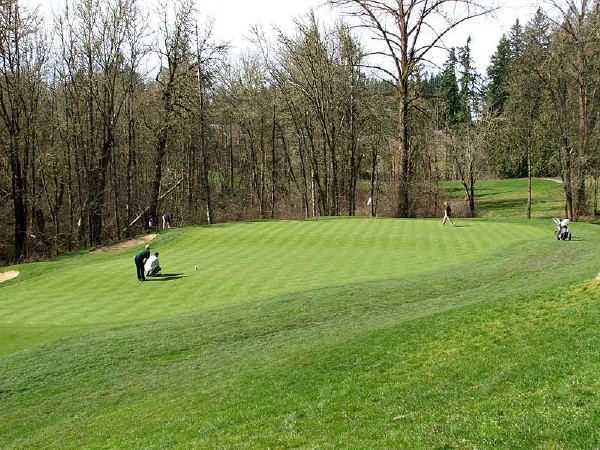
The fourth green is big, long and multi-tiered.
#5 – A.W. Tillinghast wrote that the size of a golf green ought to be in proportion to the shot it is receiving. This is something Cupp and Fought nailed at Pumpkin Ridge. Few courses in Portland offer the variety in green size that Ghost Creek enjoys; a definite strength in my book. #5 is a brute of a par 3 calling for a sweeping draw of about 200 yards to a huge green. Deep bunkers protect the left side from any run-up options and a spine cuts across the green making three putts quite likely if you do not find the same tier as the the flagstick. The hole is long, big and brash. Par is always a good score.
#6 – Many players opt to sheath the driver here. A minefield of bunkers line the left side of the fairway making accuracy uber important. Venerable Ghost Creek runs along the right from about 175 yards in, squeezing the landing area. An interesting design feature of Pumpkin Ridge Ghost Creek is Ghost Creek itself, winding throughout numerous holes, appearing from nowhere and then disappearing again (hence its’ ËœGhost’ quality.) The green on #6 is small, protected front left by a bunker and everything long is absolute terror, dropping some 40 feet towards the #7 tees. A short two-shot hole, accuracy is once again rewarded more than brute strength. Hit it in the fairway and the golfer can attack the pin, otherwise there is so much trouble all over the place, take a par and move along.
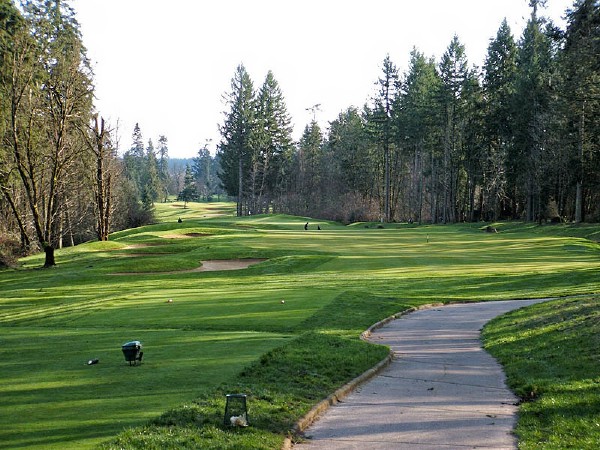
The sixth tee shot must be threaded between Ghost Creek and a smattering of bunkers.
#7 – Thus far, little about Ghost Creek is too gimmicky, but the bunkers adorning #7 surely are an eye sore. While the complex is strategically located, rising up an across the landing zone, the aesthetics are abominable. Mae West this is not. Grab the driver and blast your biggest shot. This hole is tough. Only a great drive will put a mid to short iron in your hand. The fairway bunkering may be offensive, but we are treated to a little visual deception at the green. A couple of flanking bunkers appear to be right up against the front of the green but they are about 30 yards short. Many players fail to pull enough club here so gauge your distance accurately.
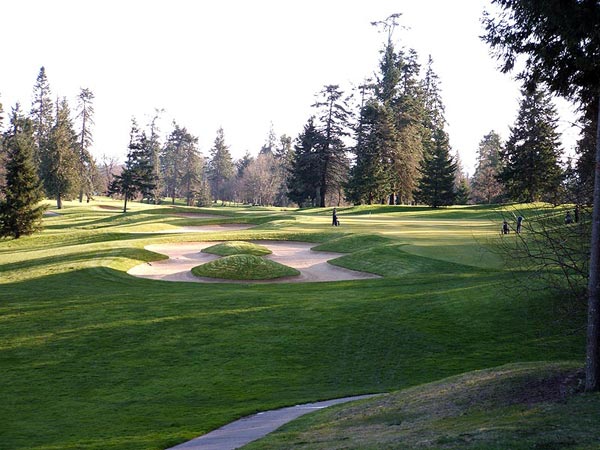
The seventh tee shot must clear the bunker with the ugly mounds in it.
#8 – Here the golfer is presented with one of the narrower shoots from which to drive from. The hole bends uphill and then gently down to the right, it can be tough to figure out what to aim at first time around. A couple of penal bunkers guard the right side but they are basically fodder. This hole is not all that long, a mammoth drive does allow for the golfer to reach it in two, but a VERY small green makes it unlikely. A couple of bunkers dot this fairway both left and right along the way to the green, but nothing about them is all that difficult to handle. Driver, whack! Fairway wood, whack! Now one is faced with a wedge shot to a tiny green. Again, I am impressed with how Cupp and Fought built the greens to match the shot required. Even with a wedge in your hand, hitting this green is tough business.
#9 – I will take this opportunity to praise Cupp and Fought for the variety of golf holes, and sequencing of said holes. #8 is a short three-shotter? Well then, #9 should be a brutal two-shotter. Playing due west; approaching weather systems cause this hole to play even longer some days. From the image, you can see the primary defense is the large pond flanking the left side of the green. Ghost Creek adorns the right side of the landing area, extremely savvy players will drive down the 1st fairway. Being as far right as possible allows one to approach the green with a run-up shot; but it is blind ¦ ¦and still risky with water left. A great deal of room is afforded the golfer off of the tee, but the further left one goes the more water they will have to fly with their approach, a nice strategic dilemna. Many golfers opt to lay up with their approach if they have not hit an ideal drive. Hard par, easy bogey comes to mind.
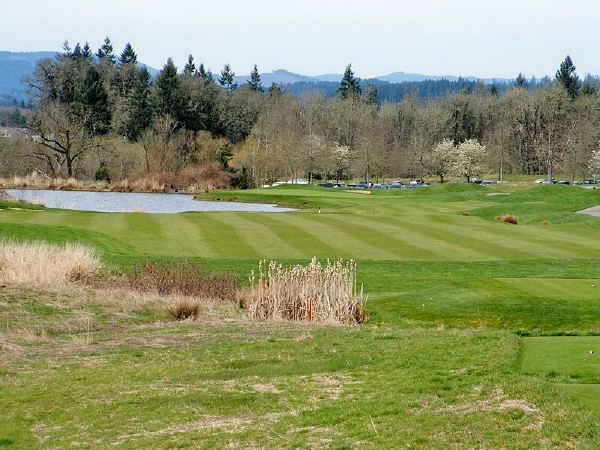
The ninth tee shot is afforded plenty of room.
#10 – At least half the time I play Ghost Creek there is a frost delay. The only conclusion I can draw is that the designers did not consider this matter when laying out the course. Not that either the 1st or 10th are bad starting holes, per se, but why not just change the nines for good if half the year golfers are forced to play the course in a different configuration?
The back nine starts with a par 5 and it might provide for a slightly quicker getaway, a la designs of George C. Thomas, than #1. The most reachable of all par 5’s on the course, allegedly, the real intrigue rests in the lay-up if one does not hit a terrific drive. Your second shot, perhaps with a wood, can be precarious depending upon your lie. An alternate fairway affords the option of a lay-up to the extreme left of the winding fairway, and while it is not necessarily a more difficult approach from here, the lay-up must be accurately hit because the left is flanked with sand to boot. I’ve often thought there really isn’t any reason NOT to hit it down the middle–take on the creek–with your second because all you do is expose yourself to more trouble yet laying up in the alternate fairway left. Either straight down the pipe or from far left, the third shot is fairly simple to a pretty plain round green without a great deal of contour to it. Hell, you could approach it from the 1st fairway! The greenside bunkers do not scare anyone. Easy par hole.
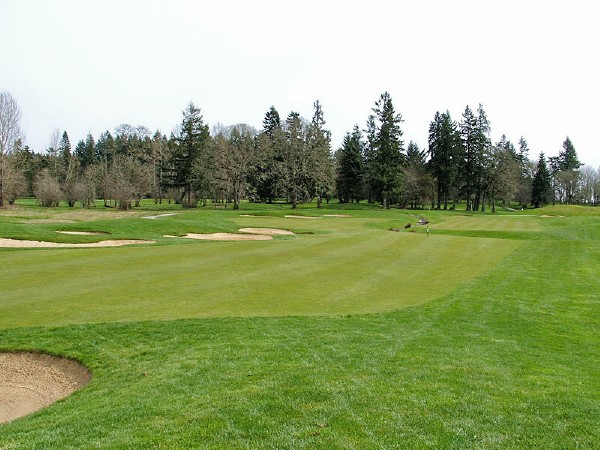
Bunkers and creek force players to make decisions at the par five tenth hole.
#11 – This is a simple but challenging par 3 playing slightly uphill. The kidney bean, two-tiered green tilts toward the player. Nothing special, birdie is a mid iron away. Meandering Ghost Creek does not come into play except to punish the worst of players, one of my least favorite concepts.
#12 – Bending right, here is one of the few true doglegs at Pumpkin. The daring will challenge the trees to the right, gaining a considerable advantage over conservatives who hit three wood down the middle. Three wood leaves about 175 in to a well-bunkered greens complex. The ideal shot would be a draw, which explains why such an advantage is to be gained by biting of the corner. Like a handful of greens complexes on the golf course, the target rests amongst the middle of a cluster of containment mounds.
#13 – This uphill two-shotter plays shorter than it looks. From here on in the fairways at Pumpkin seem to narrow a bit-this particular landing area is guarded left by a majestic fir, a bunker and more trees to the right. It is preferable to approach from the left; the green being protected by a long, deep bunker to the right running up to the front of the green from about 50 yards in. Additionally, a spine separates the green, contributing to a nice roll off at the back, one of few greens at Ghost Creek that fall away from the line of play. Pin positions located back right are challenging and fun, especially because you are hitting uphill to a downhill pin position. Tough to stop your ball when it gets firm!
#14 – Here we get a little variety in a par 3! Calling for an all downhill blast with a wide open run up area, the 14th green is a big giant punchbowl bunkered left. Probably one of the biggest greens on the golf course, club selection is difficult due to the size of the green and because when the wind is blowing you never know what your ball is going to do once it is in the air. Hit yourself a 5 or 7 wood and you run the chance of a sky ball catching that wind and coming up really short. There is nothing especially terrifying here; I like this hole quite a bit simply because it is a LONG par three.
#15 – This par five asks for another drive up a hill just like the 4th. Bending subtly to the left, a smattering of bunkers punish both a drive or second shot pulled left. Right is no good, OB over there. There really isn’t much to this three-shotter beyond whacking your best drive and three wood down the fairway. I suppose a tiger could take it home in two but the green does not set up well for the second. Leaving your second shot out to the right leaves the best angle of approach to this front bunkered, thin and small two-tiered green. A tree fairly near the green on the right makes recovery difficult. Over the green is total jail. Again, we have a green set in a bowl. Go long and right with your approach and the golfer faces a very difficult up and down, probably going to bogey or worse from there.
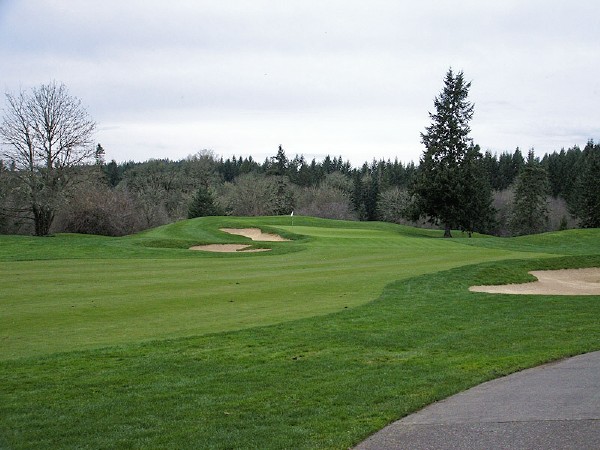
The fifteenth green, as seen from 150 yds out.
#16 – Whereas #14 is a long par three; here is the 100 yd counterpart. The green falls from back left to front right, pushing the limits of playable when you start increasing green speeds. Anything hit left, either in a bunker or OVER the bunkers is absolute jail. A shot long will fall so far down the embankment towards the 17th tee that you will probably not be able to see the top of the flagstick with your second. It is truly a hit it and hope affair ¦ ¦and you need to stop it FAST because the green will be running away from you. Like #7 at Pebble or #10 at Pine Valley, this little hole is 100 yards of sheer terror. It can totally ruin a round and drive you bonkers!!!
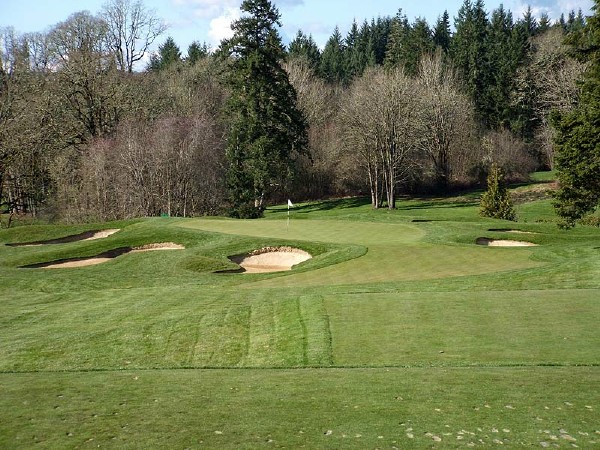
Only a wedge away, the sixteenth green can be an elusive target.
#17 – This short par 4 forces you to make all kinds of decisions on the tee box. Try to drive the green? Lay-up with a fairway wood…..mid iron maybe? Ghost Creek runs all over the place here, down the left side, cuts across the fairway and comes into play for a drive hit REALLY long down the right. It’s about a 220 or so carry to clear it if one is inclined to challenge the dance floor. Once the golfer has safely navigated their way off the tee and into the fairway, they face an approach to another long and thin, small two-tiered green guarded on the right by a stone wall bordered pond. The preferred angle of attack is definitely from the left ¦.you open up the hole from that side. I’ve seen eagles here, I’ve seen a lot of snowmen.
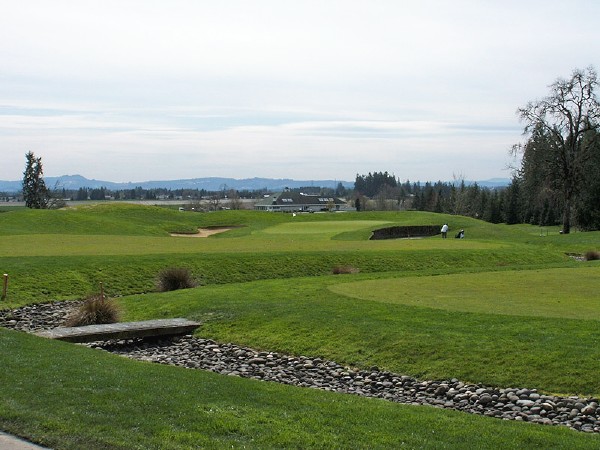
The seventeenth is a 300-yard par four, the kind of hole more golf courses need!
#18 – The finisher is a long, bunkerless, par 4; virtually a mirror image of #9. A large pond guarding the entire right side of the green defines the challenge from about 125 yards in,. The green is quite large; probably measuring 60 yards in length, forcing us to, again, pay close attention to the location of the flagstick. You have to rip your longest driver and draw it around the tree to the left, that or burn the edge of it. A drive hit to the right of the very generous landing (largest on course) calls for a 175 yd or so approach. Over the edge of the pond; this is not a shot I feel especially comfortable with, definitely not this late in the round. Getting the ideal angle of approach and appropriate distance is very important to finding success. Summed up, 18 is a very stern finisher, you do not get any gravy at the end of your round, it says only two more of your best shots will get you to the clubhouse with a par.
A round played at Ghost Creek affords the finest Portland public golf has to offer. Even in the rainy wet season the fairways are reasonably dry; the greens as nice as any in Portland at that time of the year. It is a very spacious course giving a championship caliber feel to the place. Simply put, it is the superior modern-age complex in the region; capable of holding tournaments while still providing an intimate down homey feel to the regulars. The staff is courteous, the practice balls are free and the sandwich at the turn is delicious. Like your favorite “adult” beverage, local golfers only stray from Ghost Creek for variety.
The End







